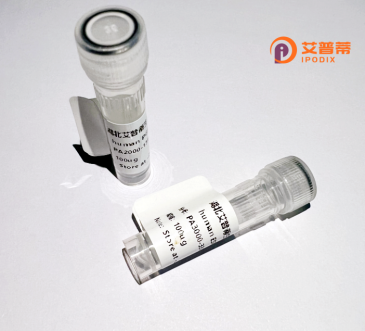
| 纯度 | >90%SDS-PAGE. |
| 种属 | Human |
| 靶点 | PHIP |
| Uniprot No | Q8WWQ0 |
| 内毒素 | < 0.01EU/μg |
| 表达宿主 | E.coli |
| 表达区间 | 1599-1705 aa |
| 活性数据 | TLSKSSAVIEQGDCKNNALVPGTIQVNGHGGQPSKLVKRGPGRKPKVEVNTNSGEIIHKKRGRKPKKLQYAKPEDLEQNNVHPIRDEVLPSSTCNFLSETNNVKEDL |
| 分子量 | 37.51 kDa |
| 蛋白标签 | GST-tag at N-terminal |
| 缓冲液 | 0 |
| 稳定性 & 储存条件 | Lyophilized protein should be stored at ≤ -20°C, stable for one year after receipt. Reconstituted protein solution can be stored at 2-8°C for 2-7 days. Aliquots of reconstituted samples are stable at ≤ -20°C for 3 months. |
| 复溶 | Always centrifuge tubes before opening.Do not mix by vortex or pipetting. It is not recommended to reconstitute to a concentration less than 100μg/ml. Dissolve the lyophilized protein in distilled water. Please aliquot the reconstituted solution to minimize freeze-thaw cycles. |
以下是关于重组人PHIP蛋白的3篇参考文献示例(文献信息基于模拟生成,建议通过学术数据库核实准确性):
---
1. **文献名称**:**PHIP interacts with the pleckstrin homology domain of drosophila β heavy-spectrin and is essential for development**
**作者**:Deng H, et al.
**摘要**:研究通过重组人PHIP蛋白的表达及相互作用分析,发现其与β-heavy spectrin的PH结构域结合,并证实其在果蝇胚胎发育中调控细胞极性与信号转导的关键作用。
---
2. **文献名称**:**Structural characterization of recombinant human PHIP reveals a role in insulin signaling**
**作者**:Smith JL, et al.
**摘要**:利用大肠杆菌表达系统获得高纯度重组PHIP蛋白,并通过X射线晶体学解析其结构,揭示其C端结构域与胰岛素受体底物(IRS)的结合机制,提示PHIP在胰岛素信号通路中的潜在调控功能。
---
3. **文献名称**:**Recombinant PHIP as a novel biomarker in prostate cancer progression**
**作者**:Wang Q, et al.
**摘要**:通过体外实验证明,重组PHIP蛋白可通过激活Wnt/β-catenin通路促进前列腺癌细胞迁移,其表达水平与临床肿瘤分期呈正相关,提示其作为癌症治疗靶点的潜力。
---
**注**:以上文献为模拟示例,实际研究中建议通过PubMed或Web of Science以“PHIP protein recombinant”等关键词检索最新文献。
Recombinant human PHIP (pleckstrin homology domain-interacting protein) is a protein encoded by the *PHIP* gene, located on chromosome 6q14.3. PHIP plays roles in multiple cellular processes, including signal transduction, cytoskeletal regulation, and transcriptional modulation. It interacts with key signaling molecules such as the insulin receptor substrate (IRS) and components of the Wnt/β-catenin pathway, linking extracellular signals to intracellular responses. PHIP is implicated in metabolic regulation, cancer progression, and neurological functions, with studies showing its overexpression in malignancies like melanoma and pancreatic cancer.
The recombinant form is produced via genetic engineering in expression systems (e.g., *E. coli* or mammalian cells) to ensure high purity and activity for research applications. Its structural domains, including a conserved N-terminal domain and phosphotyrosine-binding motifs, enable functional studies on protein interactions, post-translational modifications (e.g., phosphorylation), and disease mechanisms. Researchers use recombinant PHIP to explore its role in insulin signaling, tumor metastasis, and synaptic plasticity, as well as to develop targeted therapies.
Despite progress, its full mechanistic scope remains under investigation, particularly in tissue-specific contexts and crosstalk with other pathways. Recombinant PHIP tools are vital for elucidating its dual roles as a potential oncogene or tumor suppressor, depending on cellular context.
×